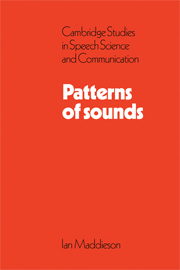Book contents
- Frontmatter
- Contents
- Dedication
- Preface
- 1 The size and structure of phonological inventories
- 2 Stops and affricates
- 3 Fricatives
- 4 Nasals
- 5 Liquids
- 6 Vocoid approximants
- 7 Glottalic and laryngealized consonants
- 8 Vowels
- 9 Insights on vowel spacing
- 10 The design of the UCLA Phonological Segment Inventory Database (UPSID)
- Appendix A Language lists and bibliography of data sources
- Appendix B Phoneme charts and segment index for UPSID languages
10 - The design of the UCLA Phonological Segment Inventory Database (UPSID)
Published online by Cambridge University Press: 04 August 2010
- Frontmatter
- Contents
- Dedication
- Preface
- 1 The size and structure of phonological inventories
- 2 Stops and affricates
- 3 Fricatives
- 4 Nasals
- 5 Liquids
- 6 Vocoid approximants
- 7 Glottalic and laryngealized consonants
- 8 Vowels
- 9 Insights on vowel spacing
- 10 The design of the UCLA Phonological Segment Inventory Database (UPSID)
- Appendix A Language lists and bibliography of data sources
- Appendix B Phoneme charts and segment index for UPSID languages
Summary
Introduction
As remarked in the preface to this volume, the discovery of generalizations concerning the content and structure of phonological inventories has been a significant objective of recent work in linguistics. UPSID is designed as a tool for research into these questions, providing uniform data from a properly balanced sample of an adequate number of languages for statistically reliable conclusions to be reached. It differs in some major ways from the Stanford Phonology Archive (SPA) compiled at Stanford University, although this archive served as a model for our work. Stanford's plan was more ambitious than the plan for UPSID, but Stanford's team found that they had to limit the size of their language sample as their work progressed. The final report includes information on the phonologies of 196 languages. A principal reason for exclusion was the scarcity of adequately detailed phonological descriptions. The variability in detail of the sources which were used also necessarily produced entries which vary in their completeness–from those which cover little more than a list of phonemes to those which are able to include a lot of allophonic details and information on phonological alternations. Thus, for retrieval of certain information, the true sample size is smaller than 196 languages. With each reduction, the likelihood that the sample is no longer representative and properly balanced increases. With Stanford's experience in mind, UPSID was designed to be narrower in the scope of information about each language entered, but to be more comprehensive in the number of languages covered.
- Type
- Chapter
- Information
- Patterns of Sounds , pp. 156 - 173Publisher: Cambridge University PressPrint publication year: 1984
- 3
- Cited by

